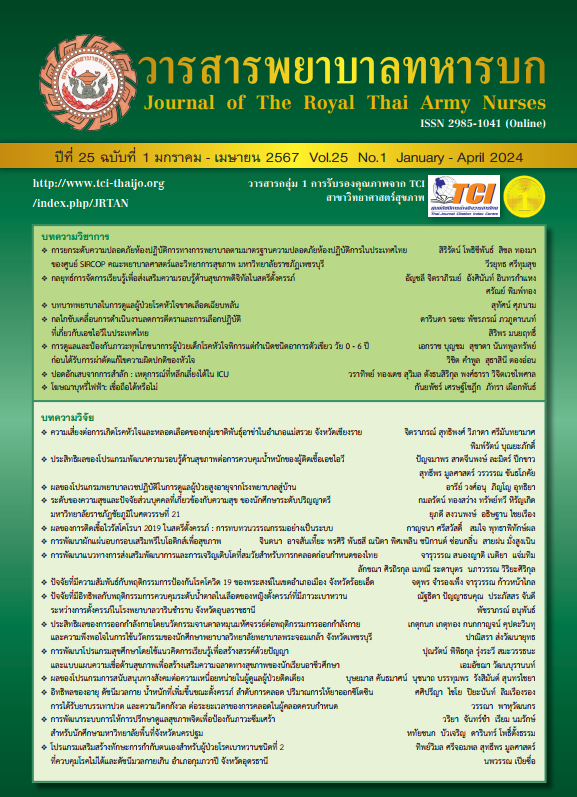Development of Crispy Vegetables Fortified with Prebiotics for Health
Keywords:
Vegetable crisps, Prebiotics, HealthAbstract
This research was the development of crispy vegetables supplemented with prebiotics. The objectives were to 1) study product prototypes 2) study nutritional values 3) design business products. The sample consisted of 120 people who did not like to eat vegetables by simple random sampling according to the inclusion and exclusion criteria. The instruments were quantitative and qualitative questionnaires. Data analysis used descriptive and content analysis.
The research results found that the vegetables had a green odor. The taste was bitter and spicy, with no flavor, not appetizing, and not eating full, Cultivation of parents who did not like to eat vegetables. From the quality of the taste of crispy vegetables supplemented with prebiotics, the product was designed as a vegetable formula consisting of pumpkin, potato, and taro. The ratio of root crops to vegetables was equal to 1:1, 1:2, and 2:1 by weight. It was found that satisfaction with the product was at a high level of 95.4%. Satisfaction in eating vegetables was at a high level of 96.8%. High liking for crispy vegetables mixed with prebiotics 88.6%. There was a high level of attitude towards eating vegetables at 94.4%. In crispy vegetables mixed with prebiotics, there were 15 nutrients per serving (15 grams), 50 kilocalories of energy, no fat, no cholesterol, 2 grams of protein, and 11 carbohydrates. grams, 3 grams of dietary fiber, 1 gram of sugar, and 140 milligrams of sodium. This product is an alternative for those who refuse to eat vegetables.
Downloads
References
Li HY., Zhou DD., Gan RY., Huang SY., Zhao CN., Shang A., & et al. Effects and Mechanisms of Probiotics, Prebiotics, Synbiotics, and Postbiotics on Metabolic Diseases Targeting Gut Microbiota: A Narrative Review. Nutrients.2021; 13(9): 3211.
Siong TE., Hardinsyah C. & Au Sook S. Status of probiotic regulations in Southeast Asia countries. Malaysian Journal of Nutrition.2021; 27(3): 507–30.
Masis N., Johnson SL., Mccaffrey J., & Chapman NK. Fruit and Vegetable Preferences and Identification by Kindergarteners through 2nd Graders with or without the US Department of Agriculture Fresh Fruit and Vegetable Program. Journal of Nutrition Education & Behavior.2017; 49(9): 752–58.
Kwon YS., Yang YY., Park Y., Park YK., & Kim S. Dietary Assessment and Factors According to Fruits and Vegetables Intake in Korean Elderly People: Analysis of Data from the Korea National Health and Nutrition Examination Survey, 2013–2018. Nutrients. 2010; 12(11): 3492.
Pokhawatana C.& Chawapradit P. Chinese morning glory. Horticulture Promotion Division. Department of Agricultural Extension;1996. (in Thai).
Saelim S. Comparative analysis of chlorophyll content in Chinese morning glory watered with different substances by visible spectrophotometry, Chemistry program. Nakhon Pathom Rajabhat Institute. 2004. (in Thai).
Jaiphakdee R. Leafy vegetables. 2nd edition. Bangkok: Sunlight for Children.2001. (in Thai).
Yadav M., Jain S., Tomar R., Prasad G., & Yadav H. Medicinal and biological potential of pumpkin: An updated review. Nutrition Research Reviews.2010; 23(2): 184-90.
Tripathy A., Dash J., Kancharla S., Kolli P., Mahajan D., Senapati S., & et al. Probiotics: A Promising Candidate for Management of Colorectal Cancer. Cancers.2021; 13(13): 3178.
Kadey M. Don’t Bypass the Frozen Foods. Environmental Nutrition.2012; 44(11): 4.
Nuallaong S. Biotic extraction from agricultural plants. Prince of Songkhla University.2009. (in Thai).
Duvauchelle J. Gut Healing Kid-approved supplements. Alive: Canada’s Natural Health & Wellness Magazine.2022; 478: 15–6.
Holley CE., Farrow C., & Haycraft E. If at first, you don’t succeed: Assessing influences associated with mothers’ reoffering of vegetables to preschool-age children. Appetite. 2018;123: 249–55.
Wu H., & Chiou J. Potential Benefits of Probiotics and Prebiotics for Coronary Heart Disease and Stroke. Nutrients. 2012; 13(8): 2878.
Lakkananurak N. How to eat crispy vegetables and fruits for benefit. Chulalongkorn Hospital, Thai Red Cross Society.2012. (in Thai).
Laochai W., Intarakamhang U.,& Poonpol P. Development of Health Innovation by Using Design Thinking Process. Journal of the Royal Thai Army Nurses. 2023; 23 (2):53-60. (in Thai).
Downloads
Published
How to Cite
Issue
Section
License
Copyright (c) 2024 Journal of The Royal Thai Army Nurses

This work is licensed under a Creative Commons Attribution-NonCommercial-NoDerivatives 4.0 International License.
บทความหรือข้อคิดเห็นใดใดที่ปรากฏในวารสารพยาบาลทหารบกเป็นวรรณกรรมของผู้เขียน ซึ่งบรรณาธิการหรือสมาคมพยาบาลทหารบก ไม่จำเป็นต้องเห็นด้วย
บทความที่ได้รับการตีพิมพ์เป็นลิขสิทธิ์ของวารสารพยาบาลทหารบก
The ideas and opinions expressed in the Journal of The Royal Thai Army Nurses are those of the authors and not necessarily those
of the editor or Royal Thai Army Nurses Association.






